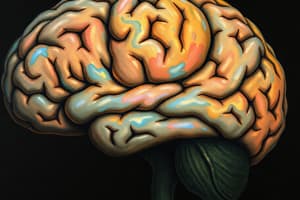Podcast
Questions and Answers
Which region of the brain plays a major role in controlling body temperature, hunger, thirst, and hormone secretion?
Which region of the brain plays a major role in controlling body temperature, hunger, thirst, and hormone secretion?
- Epithalamus
- Thalamus
- Hypothalamus (correct)
- Midbrain
Which part of the brainstem is responsible for functions like regulation of heart rate, breathing, and balance?
Which part of the brainstem is responsible for functions like regulation of heart rate, breathing, and balance?
- Medulla Oblongata (correct)
- Pons
- Thalamus
- Midbrain
Which lobe of the cerebrum is primarily responsible for processing visual information?
Which lobe of the cerebrum is primarily responsible for processing visual information?
- Frontal Lobe
- Occipital Lobe (correct)
- Temporal Lobe
- Parietal Lobe
Which area of the brain is associated with Broca's aphasia, affecting speech production?
Which area of the brain is associated with Broca's aphasia, affecting speech production?
What is the main function of the cerebellum in the brain?
What is the main function of the cerebellum in the brain?
Which part of the brainstem contains nuclei responsible for functions like chewing, swallowing, and salivation?
Which part of the brainstem contains nuclei responsible for functions like chewing, swallowing, and salivation?
Which region of the brainstem is involved in visual reflexes and auditory nerve pathways?
Which region of the brainstem is involved in visual reflexes and auditory nerve pathways?
Flashcards are hidden until you start studying
Study Notes
Central Nervous System (CNS)
- The CNS consists of the brain and spinal cord.
Brain: Major Regions
- The brain has four major regions: Diencephalon, Brainstem, Cerebrum, and Cerebellum.
Diencephalon
- The Diencephalon is divided into three parts: Thalamus, Epithalamus, and Hypothalamus.
- Thalamus:
- Largest part of the Diencephalon.
- Influences mood and registers pain.
- Epithalamus:
- Small area superior and posterior to the Thalamus.
- Involved in emotional and visceral response to odors.
- Pineal body is located in the Epithalamus and plays a role in the onset of puberty.
- Hypothalamus:
- Most inferior part of the Diencephalon.
- Important in maintaining homeostasis.
- Regulates body temperature, hunger, and thirst.
- Plays a central role in controlling hormone secretion from the pituitary gland.
Brainstem
- The Brainstem connects the spinal cord to the rest of the brain.
- The Brainstem is divided into three parts: Medulla Oblongata, Pons, and Midbrain.
Medulla Oblongata
- Inferior part of the Brainstem.
- Continuous with the spinal cord.
- Extends from the foramen magnum to the pons.
- Contains cranial nerves (CN) 9, 10, 11, and 12.
- Regulates heart rate, blood vessel diameter, breathing, swallowing, vomiting, coughing, sneezing, and balance.
Pons
- Immediately superior to the Medulla Oblongata.
- Means "bridge" in Latin.
- Contains cranial nerves (CN) 5, 6, 7, and 8.
- Lower part of the Pons controls breathing, swallowing, and balance.
- Other nuclei in the Pons control functions such as chewing and salivation.
Midbrain
- Superior to the Pons.
- Smallest region of the Brainstem.
- Contains cranial nerves (CN) 3 and 4.
- Found superior and inferior colliculi.
- Superior colliculi: involved in visual reflexes and turning the head.
- Inferior colliculi: major relay centers for auditory nerve pathways in the CNS.
- General functions: coordination of eye movements and control of pupil diameter and lens shape.
- Contains a nuclear black mass called Substantia Nigra, which is associated with Parkinson's Disease and Levodopa treatment.
Cerebrum
- Largest part of the brain.
- Divided into left and right hemispheres by a longitudinal fissure.
- The surface of each hemisphere is wrinkled by presence of eminences called Gyri and furrows called Sulci or Fissures.
- The Cerebrum is divided into four lobes: Frontal, Parietal, Occipital, and Temporal.
Frontal Lobe
- Principal motor area (4).
- Important in the control of voluntary motor functions, motivation, aggression, mood, and olfactory (smell) reception.
- Brocas area (44, 45) is associated with Brocas aphasia (executive, motor, nonfluent, anterior).
Parietal Lobe
- Principal center for the reception and conscious perception of most sensory information, such as touch, pain, temperature, balance, and taste.
- Principal sensory area (3, 1, 2).
Occipital Lobe
- Functions in the reception and perception of visual input.
- Principal visual cortex (17).
Temporal Lobe
- Involved in olfactory (smell) and auditory sensations and plays an important role in memory.
- Associated with abstract thought and judgment.
- Primary auditory cortex (41, 42).
- Wernicke's area (22) is associated with Wernicke's aphasia (receptive, sensory, fluent, posterior).
Cerebellum
- Composed of gray matter.
- Posterior and inferior to the Cerebrum.
- Involved in balance, maintenance of muscle tone, and coordination of fine motor movements.
- Major function of the Cerebellum is that of a comparator.
- Also involved in learning motor skills (e.g., riding a bicycle, playing a piano).
Spinal Cord
- Extends from the foramen magnum to L2 (before the 2nd lumbar vertebra).
- Has a central gray part organized into horns and a peripheral white part forming nerve tracts.
- Roots of the spinal nerve extend out of the cord.
Vertebral Column
- Surrounds and protects the spinal cord.
- Divided into five regions: Cervical (7), Thoracic (12), Lumbar (5), Sacral (5), and Coccyx (4 fused vertebra).
Studying That Suits You
Use AI to generate personalized quizzes and flashcards to suit your learning preferences.




